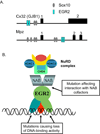The molecular machinery of myelin gene transcription in Schwann cells
- PMID: 18803322
- PMCID: PMC2930200
- DOI: 10.1002/glia.20767
The molecular machinery of myelin gene transcription in Schwann cells
Abstract
During late fetal life, Schwann cells in the peripheral nerves singled out by the larger axons will transit through a promyelinating stage before exiting the cell cycle and initiating myelin formation. A network of extra- and intracellular signaling pathways, regulating a transcriptional program of cell differentiation, governs this progression of cellular changes, culminating in a highly differentiated cell. In this review, we focus on the roles of a number of transcription factors not only in myelination, during normal development, but also in demyelination, following nerve trauma. These factors include specification factors involved in early development of Schwann cells from neural crest (Sox10) as well as factors specifically required for transitions into the promyelinating and myelinating stages (Oct6/Scip and Krox20/Egr2). From this description, we can glean the first, still very incomplete, contours of a gene regulatory network that governs myelination and demyelination during development and regeneration.
Figures



References
-
- Arthur-Farraj P, Mirsky R, Parkinson DB, Jessen KR. A double point mutation in the DNA-binding region of Egr2 switches its function from inhibition to induction of proliferation: A potential contribution to the development of congenital hypomyelinating neuropathy. Neurobiol Dis. 2006;24(1):159–169. - PubMed
-
- Bellone E, Di Maria E, Soriani S, Varese A, Doria LL, Ajmar F, Mandich P. A novel mutation (D305V) in the early growth response 2 gene is associated with severe Charcot-Marie-Tooth type 1 disease. Hum Mutat. 1999;14(4):353–354. - PubMed
-
- Bermingham JR, Jr, Scherer SS, O'Connell S, Arroyo E, Kalla KA, Powell FL, Rosenfeld MG. Tst-1/Oct-6/SCIP regulates a unique step in peripheral myelination and is required for normal respiration. Genes Dev. 1996;10(14):1751–1762. - PubMed
-
- Bermingham JR, Jr, Shearin H, Pennington J, O'Moore J, Jaegle M, Driegen S, van Zon A, Darbas A, Ozkaynak E, Ryu EJ, et al. The claw paw mutation reveals a role for Lgi4 in peripheral nerve development. Nat Neurosci. 2006;9(1):76–84. - PubMed
Publication types
MeSH terms
Substances
Grants and funding
LinkOut - more resources
Full Text Sources
Other Literature Sources
Molecular Biology Databases

